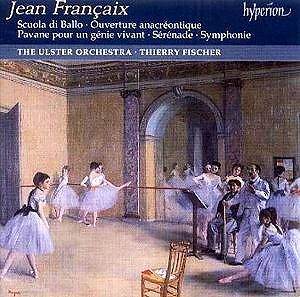 Composer: Jean Françaix
Composer: Jean Françaix
Works: Symphony in G major (1953), Sérénade (1934), Ouverture anacréontique (1978), Pavane pour un Génie vivant (1987), Scuola di Ballo (1933)
Performers: Ulster Orchestra, Thierry Fischer (conductor)
Recording: Ulster Hall, Belfast, September 2001
Label: Hyperion CDA 67323
Jean Françaix, a quintessential figure of French neo-classicism, navigated the 20th century with a distinctive voice that combined wit, clarity, and elegance. The present recording showcases a selection of his orchestral works, revealing the composer’s unwavering commitment to melodic invention and rhythmic vitality. This collection is particularly significant as it highlights Françaix’s ability to engage with historical styles while imbuing them with his own stylistic flourishes, a hallmark of his artistic identity.
The Symphony in G major, completed in 1953, serves as a tribute to the classical tradition, particularly to Haydn, from whom Françaix draws inspiration in both structure and spirit. Its four short movements exhibit a delightful interplay of humor and sophistication, with the third movement—a Minuet and Trio—standing out for its playful charm and elegant phrasing. Thierry Fischer’s direction brings forth the symphony’s buoyant character, ensuring that the orchestral texture remains transparent, allowing each instrument’s voice to resonate clearly. Notably, the Ulster Orchestra’s woodwinds shine in their crisp articulation, particularly in the lively exchanges that define the symphony’s character.
Françaix’s earlier work, Sérénade, is a gem of orchestral writing, notable for its lyrical beauty and masterful orchestration. Here, the orchestral color is vividly realized, with Fischer coaxing warm, rich tones from the strings while the winds weave intricate lines that dance gracefully throughout the piece. The work’s charming melodies are expertly balanced against the rhythmic underpinning, creating a buoyant atmosphere that never feels forced. The recording captures the nuances of the performance, with an impressive clarity that allows the listener to appreciate the intricate interplay between the different sections of the orchestra.
Of particular interest is the Ouverture anacréontique, which showcases Françaix’s flair for combining structural rigor with playful inventiveness. The work opens with a slow introduction, beautifully rendered by the orchestra, leading into a jubilant middle section that invites the listener to revel in its rhythmic exuberance. Fischer’s pacing here is judicious, allowing the exuberance to build organically, culminating in a brilliant coda that delights with its clever thematic restatement. The engineering quality of this recording is praiseworthy; the acoustic balance captures the orchestra’s dynamic range, from the intimate whispers of the strings to the brilliant exclamations of the brass.
The Pavane pour un Génie vivant, composed in homage to Ravel, evokes a poignant simplicity that Françaix masterfully exploits. The opening phrase is almost a mirror image of Ravel’s own Pavane pour une Infante Défunte, yet Françaix’s treatment transforms it into a heartfelt tribute. This piece exemplifies the composer’s ability to distill emotion from simplicity, and the Ulster Orchestra’s performance does justice to its understated beauty, with Fischer ensuring that each note is imbued with the appropriate level of expressiveness.
With Scuola di Ballo, Françaix’s early ballet score, we witness the playful spirit that permeates much of his oeuvre. Scored for a smaller ensemble, the piece delights with its lightness and charm, perfectly encapsulating the neo-classical zeitgeist of the early 20th century. The Ulster Orchestra’s adept handling of the score’s intricacies reflects a deep understanding of the stylistic nuances inherent in Françaix’s music, making this performance a joy to behold.
This recording not only serves as an excellent introduction to Françaix’s orchestral music but also stands as a testament to the composer’s enduring legacy. The Ulster Orchestra, under Fischer’s insightful direction, brings a refreshing vibrancy to each work, revealing the intricacies and joys of Françaix’s style. The sound engineering enhances the listening experience, ensuring that the performances are both engaging and sonically pleasing. This collection of Françaix’s works is a commendable addition to the catalog, deserving of recognition and repeated listening.



